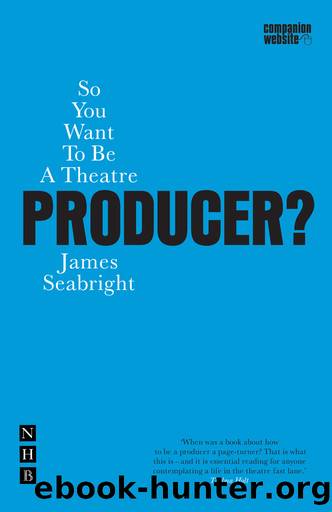So You Want To Be A Theatre Producer? by James Seabright

Author:James Seabright [Seabright, James]
Language: eng
Format: epub
Publisher: Nick Hern Books
Paper size
Millimetres wide × high
A1 (Poster)
594 × 841
A2 (Poster) like a broadsheet
420 × 594
A3 (Poster) like a tabloid
297 × 420
A4 (Letter)
210 × 297
A5 (Leaflet)
148 × 210
1/3 A4 (Leaflet)
99 × 210
A6 (Postcard)
105 × 148
B2 (Poster)
500 × 707
Double Crown (Poster)
508 × 762
Bo (Large poster)
1000 × 1414
Four Sheet (Large poster)
1016 × 1524
PRINT QUANTITY
It is always cheaper to get all the print you will need for a show done in one go. Going back later for a further print run will be more expensive than getting it all done together, because the set-up costs involved for the printer make up a fair chunk of the cost of each job. Of course, you don’t want to print so much material that you end up with a lot of wastage, but it certainly makes sense to have some spare stock to hand in case you decide to add some unplanned marketing or distribution activity to help stimulate sales. When working out how much print to get done, you should allow for your own marketing activity as well as just the basic amount requested by the venue or venues where the show is playing. As a guide, a typical fringe show playing a four-week run might print 10,000 leaflets and 500 posters; those quantities may be similar to those requested by a big touring venue where a show is playing a week.
PRINT COLOURS
The full-colour print that you are used to seeing in magazines and most newspapers is based upon the combination of four standard ink colours in various ratios: Cyan, Magenta, Yellow, and Black. Whereas it used to be quite common to print work in any number of colours between one (normally just black) and four (usually full colour, i.e. CMYK), the preponderance of full-colour printing now means that it is generally not economical to get anything printed in two or three colours. For example, even if your design only features the colours black and red, you’re unlikely to save anything on the print costs by getting anything less than a four-colour print job done. However, it remains quite common to have jobs printed or overprinted in just a single colour, normally black, as there remains quite a high demand for this service. Printers often refer to the number of ink colours on each side of a document using the formation Front/Back. So, a double-sided full-coloured print job would be referred to as 4/4, whereas a double-sided item which is full colour on the front and black only on the reverse would be 4/1.
OVERPRINTING
When getting a print run done for a tour, it is common practice to leave a space on posters and leaflets that will be overprinted with specific venue details. Sometimes overprinting will happen at the same time as the initial print run (which will make it cheaper); sometimes the initial run is done and then overprinting happens later. The overprint is normally done only in black ink so it isn’t too expensive, although any number of colours can be overprinted. A poster or leaflet printed with the basic design but without any venue details is referred to as a ‘shell’.
Download
This site does not store any files on its server. We only index and link to content provided by other sites. Please contact the content providers to delete copyright contents if any and email us, we'll remove relevant links or contents immediately.
| Acting & Auditioning | Broadway & Musicals |
| Circus | Direction & Production |
| History & Criticism | Miming |
| Playwriting | Puppets & Puppetry |
| Stage Lighting | Stagecraft |
Call Me by Your Name by André Aciman(18952)
Ready Player One by Cline Ernest(12828)
How to Be a Bawse: A Guide to Conquering Life by Lilly Singh(6686)
Wiseguy by Nicholas Pileggi(4581)
The Kite Runner by Khaled Hosseini(4414)
On Writing A Memoir of the Craft by Stephen King(4204)
The Crown by Robert Lacey(4098)
Audition by Ryu Murakami(4091)
Call me by your name by Andre Aciman(4064)
Harry Potter and the Cursed Child: The Journey by Harry Potter Theatrical Productions(3953)
Gerald's Game by Stephen King(3913)
The Perils of Being Moderately Famous by Soha Ali Khan(3781)
Dialogue by Robert McKee(3575)
Dynamic Alignment Through Imagery by Eric Franklin(3481)
Apollo 8 by Jeffrey Kluger(3196)
How to be Champion: My Autobiography by Sarah Millican(3180)
Seriously... I'm Kidding by Ellen DeGeneres(3098)
Darker by E L James(3086)
History of Dance, 2E by Gayle Kassing(2997)
